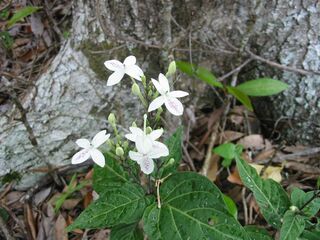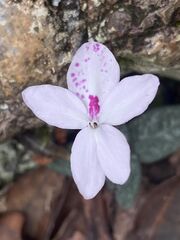Biology:Pseuderanthemum variabile
| Pastel flower | |
|---|---|

| |
| At McKay Reserve, Palm Beach, NSW, January 2018 | |
Script error: No such module "Conservation status".
| |
| Scientific classification | |
| Kingdom: | Plantae |
| Clade: | Tracheophytes |
| Clade: | Angiosperms |
| Clade: | Eudicots |
| Clade: | Asterids |
| Order: | Lamiales |
| Family: | Acanthaceae |
| Genus: | Pseuderanthemum |
| Species: | P. variabile
|
| Binomial name | |
| Pseuderanthemum variabile (R.Br.) Radlk.[1]
| |
| Synonyms[1] | |
|
List
| |
Pseuderanthemum variabile, commonly known as pastel flower or love flower in its native range, or night and afternoon in the United States , is a small perennial herb in the family Acanthaceae which is native to Australia , Papua New Guinea and New Caledonia. It can be an unwelcome nuisance in orchid nurseries in Australia.
Description
Pseuderanthemum variabile is a creeping herb with a highly variable appearance, growing up to 30 cm (12 in) high, all parts of which may be pubescent. The wiry stems are around 1–2 millimetres (0.04–0.08 in) wide. The leaves are lanceolate to ovate in shape with entire margins, and their arrangement is opposite and decussate. They measure up to 7 cm (2.8 in) long by 4 cm (1.6 in) wide with petioles up to 30 mm (1.2 in) long, and have from 3 to 6 lateral veins either side of the midrib.[2][3][4]
The leaf colour varies greatly. The upper surface is usually dark green to mid-green, but may have varying amounts of light grey or (rarely) purple patterning. The lower surface of the leaf is usually light green but may also be purple or dark red (see gallery for examples).
The inflorescence is produced from the terminal axil, and the zygomorphic flowers have five petals.[4] Two petals are smaller than the others and are usually uppermost. They measure around 7 by 4 mm (0.28 by 0.16 in) and overlap each other slightly. Two more are held perpendicular to the first pair, one on either side, and the last (and largest) petal is opposite the first pair. This one measures about 10 by 6 mm (0.39 by 0.24 in) and is often decorated with a variable number of small purple spots. The petals may be any colour shade from white to pink or lilac.[2][3][4]
The fruit is a capsule up to 15 mm (0.59 in) long, and may be pubescent or glabrous.[2][4]
Taxonomy
The basionym of this species is Eranthemum variabile which was first described by the Scottish botanist Robert Brown in his book Prodromus Florae Novae Hollandiae et Insulae Van Diemen published in 1810.[5][6] In 1883 the Germany taxonomist and botanist Ludwig Radlkofer transferred a number of species, including E. variablile, to the new genus Pseuderanthemum.[7]
Distribution and habitat
This species is found in Papua New Guinea, eastern parts of New South Wales and Queensland in Australia, and in New Caledonia.[2][3][8][9] It may occupy a number of forest types in Australia, most often rainforest and wet sclerophyll forest, but also woodlands, open forest and deciduous vine thickets.[2][3]
It has been introduced to Florida, South Carolina and Puerto Rico.[1]
Ecology
P. variabile is the food plant for caterpillars of a number of butterflies in the family Nymphalidae, including Doleschallia bisaltide, Hypolimnas alimena, Hypolimnas bolina, Hypolimnas misippus and Junonia orithya.[10]
Conservation
This species is listed by the Queensland Department of Environment and Science as least concern.[11] (As of April 2022), it has not been assessed by the IUCN.
Cultivation and uses
It is an attractive addition to gardens, and can be used as a feature, a ground cover, or a gap filler in a rockery. It is easily grown from seed or cuttings.[4]
In Australia, it is reported by some orchid nurseries as a pest, as it often appears in pots and may be difficult to eradicate.[4][12]
Gallery
References
- ↑ 1.0 1.1 1.2 "Pseuderanthemum variabile". Royal Botanic Gardens, Kew. https://powo.science.kew.org/taxon/urn:lsid:ipni.org:names:53355-1.
- ↑ 2.0 2.1 2.2 2.3 2.4 "PlantNET - FloraOnline". Royal Botanic Gardens and Domain Trust, Sydney. https://plantnet.rbgsyd.nsw.gov.au/cgi-bin/NSWfl.pl?page=nswfl&lvl=sp&name=Pseuderanthemum~variabile.
- ↑ 3.0 3.1 3.2 3.3 "Pseuderanthemum variabile". Centre for Australian National Biodiversity Research (CANBR), Australian Government. 2020. https://apps.lucidcentral.org/rainforest/text/entities/Pseuderanthemum_variabile.htm.
- ↑ 4.0 4.1 4.2 4.3 4.4 4.5 Howes, Jeff (27 July 2020). "Pseuderanthemum variabile". The Australian Plants Society NSW Ltd. https://resources.austplants.com.au/plant/pseuderanthemum-variabile/.
- ↑ "Eranthemum variabile". Royal Botanic Gardens, Kew. 2021. https://www.ipni.org/n/48932-1.
- ↑ Prodromus floræ Novæ Hollandiæ et Insulæ Van-Diemen. https://www.biodiversitylibrary.org/page/36315754. Retrieved 30 April 2022.
- ↑ "Pseuderanthemum". Royal Botanic Gardens, Kew. 2022. https://www.ipni.org/n/30014612-2.
- ↑ Conn, B.J.. "Census of Vascular Plants Of Papua New Guinea". https://www.pngplants.org/cgi-bin/PNGcensus.pl?fam=&gen=pseuderanthemum&sp=variabile&infr=&group=.
- ↑ "Pseuderanthemum variabile (R.Br.) Radlk.". https://endemia.nc/en/flore/fiche3260.
- ↑ "HOSTS - a Database of the World's Lepidopteran Hostplants". https://www.nhm.ac.uk/our-science/data/hostplants/search/list.dsml?searchPageURL=index.dsml&Familyqtype=starts+with&Family=&PFamilyqtype=starts+with&PFamily=&Genusqtype=starts+with&Genus=&PGenusqtype=equals&PGenus=Pseuderanthemum&Speciesqtype=starts+with&Species=&PSpeciesqtype=equals&PSpecies=variabile&Country=&sort=Family.
- ↑ "Species profile—Pseuderanthemum variabile". Queensland Government. https://apps.des.qld.gov.au/species-search/details/?id=16375.
- ↑ "Pseuderanthemum variabile 'Love Flower' 'Pastel Flower' What a pest of a weed in orchid collections.!!". https://www.australianorchids.com.au/blogs/blog/75807237-pseuderanthemum-variabile-love-flower-pastel-flower-what-a-pest-of-a-weed-in-orchid-collections?comment=129412792391#Comments.
External links
- View a map of recorded sightings of this species at the Australasian Virtual Herbarium
- View observations of this species on iNaturalist
- See images of this species on Flickriver
Wikidata ☰ Q5413582 entry
 |







